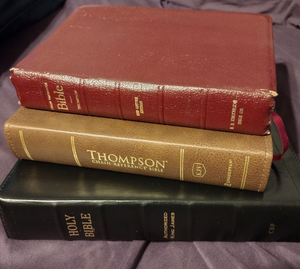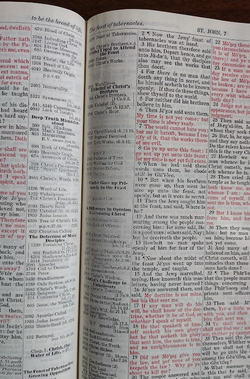Thompson Chain Reference Bible
The Thompson Chain Reference Bible is a topical study Bible originally published in 1908, and currently published by Zondervan.
Description
As a minister in the Methodist Episcopal Church of Genesee in New York, and disappointed with the study bibles of his day due to lack of material as well as cohesion, Frank C. Thompson in 1890 first wrote down his "thought suggestions" on paper and in the margins of his personal Bible. These in turn were seen by his parishioners, who, in addition to his wife, encouraged him to complete his work and get it published. Gradually, his "thought suggestions" went from one verse to the next related verse, connecting them into what he called "chains" of specific topics; the work was completed in 1908, and based upon the King James Version. In 1913 he would partner with B. B. Kirkbride and create a new publishing company, producing five editions over more than a century before the rights were sold to HarperCollins in 2020[1]. Thompson himself would supervise each edition until his passing on May 3, 1940 in Santa Monica, California[2].
With the publication of the fifth edition in 1988, the Thompson Chain Reference Bible contained more than 100,000 cross references on many topics, filed within a "topical index" at the end of the Bible itself, and arranged both numerically and alphabetically[3]. The chain system is unbiased; there is no running commentary within the text, leaving it one of the very few study Bibles which lacks this feature. In addition, the following additional helps were placed as instructional and educational material:
- Principles of Bible Study
- A short statement on studying the Bible, by the author
- Condensed cyclopedia of topics and texts
- An index of topics and associated chains of texts.
- Outline studies of the Bible
- Condensed outlines of each book, with a history of the Bible, and a brief history of the period between Old and New Testaments.
- Analyses of the books of the Bible
- Each book is given an analysis; what it's about, main theme and thought, central character, etc.
- Character studies
- Prominent individuals are studied.
- Chronologies, such as those of Moses, Jesus, the Apostles, etc.[4]
- Bible harmonies and illustrated studies, which included life trees of Moses, Jesus, and Paul; pictorial "footprint" maps, charts, and outlines.
- A dictionary of archaic words found in the King James Version (included with the fifth edition).
- Archaeological supplement
- First included with the fourth edition in 1964, written by Dr, Frederick G. Owen, and given inclusion into the chain system.
- Concordance
- Bible maps
The sixth edition by Zondervan - also known as the "Comfort Print" edition based upon the type font used - was published in 2022 with a more pleasing layout of the text and the chain system; however, the maps and instructional material included by Thompson, in addition to the archaeological supplement, were removed. As of 2024, The Thompson Chain Reference Bible is available in the following versions:
- King James Version
- New King James Version
- New American Standard Version
- New International Version
- English Standard Version[5].
How it works
When the Thompson Chain is opened, the reader will see the text of the Bible laid out in a four-column format: the two main columns in the center containing the Biblical text, and the marginal columns to the left and right, containing the numbers of the chain system. For example, in Exodus 11:1, the topic of the verse is foreknowledge; the chain number is 1312. The chain invites the reader to the next verse written down in the margin, which is Exodus 12:31. The number 1312 is also cross-referenced in the topical index, listing the prominent verses on that topic; the topical index entry will also direct the reader to any related topics, of which for this example is number 2861, predestination. The result of such a system allows the reader to have a literal "scripture-interprets-scripture" method of study, giving a clear meaning to the chapters and books as a whole without the cloud of bias present in traditional study Bibles.
References
- ↑ https://www.harpercollinschristian.com/blog/2020/12/03/harpercollins-christian-publishing-acquires-the-thompson-chain-reference-bible-assets/
- ↑ https://www.findagrave.com/memorial/33694741/frank-charles-thompson
- ↑ https://www.zondervan.com/p/thompsonchainreference/howitworks/
- ↑ The chronology at the head of nearly all the chapters is based upon the conclusions of Bishop James Ussher as per the 5th edition, topic #4222-b; the editors of the Thompson did not regard them as accurate, but used them as a working model.
- ↑ https://www.zondervan.com/p/thompsonchainreference/revisededitions/
- Thompson Chain Reference Bible, third edition, at the Internet Archive [1]

